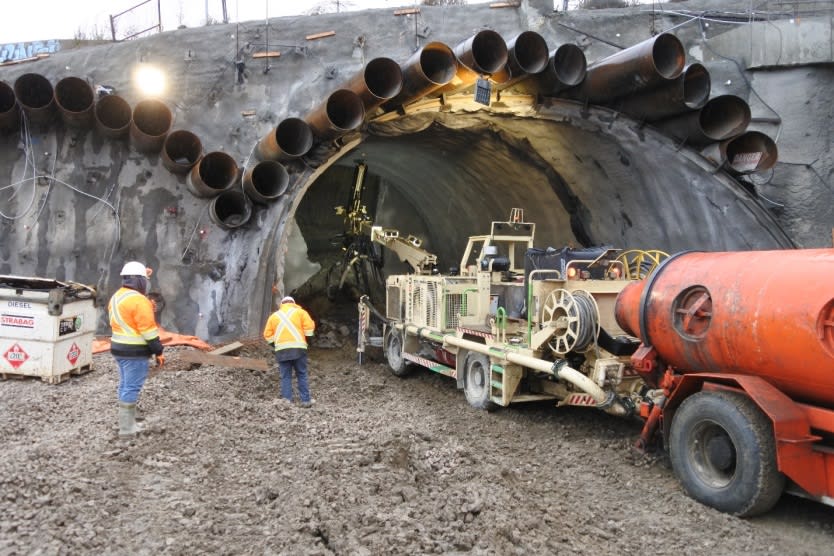Video: Tunneling begins under Hwys. 401 and 409 for GO tunnel
We break down the details of how crews are drilling below a busy stretch of Toronto highway.
Dec 16, 2019
Most Toronto drivers commuting along the interchange of Hwy. 401 and Hwy. 409 have no idea what’s taking place just below the well-worn pavement they’re travelling along.
And that’s just the way crews working on a GO tunnel have planned it, because their new train tunnel shouldn’t impact the vehicular one that’s in constant motion just above them.
Tunneling has now started underneath 21 live lanes of traffic – an impressive challenge given it is one of the busiest sections of highway in North America.
To keep the road traffic flowing during construction, Metrolinx and Toronto Tunnel Partners are using innovative technology to get the job done. Let’s take a deeper look into the engineering techniques being used for the subterranean project.
Hang on – we’re digging deep into the gritty details here.
Sequential excavation method (SEM) is a modern tunnel design and construction technique. Earth, rock and other debris is removed in a safe and consistent manner.
To do this, crews divide the tunnel into two sections. One is the upper section and the second is, not surprisingly, the lower section. Separate sections are perfect for digging in shallow mined tunnels or conditions where the ground is completely dry.
SEM intermittently removes one metre sections at a safe and steady pace.
Excavation of the top section of the tunnel. (Metrolinx photo)
Many specialized pieces of equipment are needed to excavate the tunnel smoothly.
This includes a ‘scooptram’ front end loader that moves into the tunnel to haul away about five tonnes of material at a time.
A scooptram in motion at the site. (Metrolinx photo)
“The start of tunneling is moving us one step closer to providing two-way, all-day train service on the Kitchener line,” said Sudhir Bagde, Metrolinx project manager.
”Tunneling sets the infrastructure for us to build additional tracks for the GO expansion program and expand service on the Kitchener line.”
During the excavation, the exposed area in the tunnel is immediately supported by spraying a thin layer of pressurized concrete, known as ‘shotcrete’. The concrete is sprayed on the ceiling, walls and sides, which is followed by the installation of the reinforced temporary lining. This is known as ‘welded wire fabric’, and helps hold the structure of the tunnel in place.
As an additional safety measure, lattice girders are installed to provide extra support to the newly excavated tunnel sections.
The shotcrete robot in action spraying pressurized concrete to the excavated top of the tunnel. (Metrolinx photo)
If you want to see the shotcrete robot in action, here’s a short video, to give you a better idea.
“Tunneling under 21 live lanes is impressive, especially without disrupting traffic,” said Timothy Glenn, Metrolinx project manager.
“When complete, it will benefit commuters by reducing daily travel time.”
Lattice girders used to support the tunnel during excavation. (Metrolinx photo)
In the spring, canopy tubes were installed using the auger boring method. A series of 12-metre-long pipes were hydraulically pushed under the highway with a 0.795 metre diameter drill bit that remains one to two metres back from the face of the pipe. The auger rotates inside the pipe to remove the soil.
The ‘Jack and Bore’ process, also known as ‘auger boring’. (Metrolinx photo)
Auger boring is an important step to complete prior to excavation because it sets a solid structure for the tunnel.
The Jack and Bore process completed on the east portal. (Metrolinx photo)
To help increase capacity on the Kitchener Corridor, which passes under highways 401 and 409 through a tunnel, infrastructure upgrades are required:
- Construction of two GO rail tunnels under highways 401/409 to accommodate two additional tracks, future electrification, signaling and communications infrastructure
- Replacing footings of retaining walls that support the ramp from eastbound Hwy. 409 to eastbound Hwy. 401
When the project is complete, the length of two single track tunnels will each total approximately 180 metres. The construction team will excavate 31,000 cubic metres of material – that’s about 12 Olympic-size swimming pools and use over 8,000 cubic metres of shotcrete.
And all, without most drivers above noticing what’s taking place just below.
Editor’s Note – This story was updated on Jan. 9, 2020 to better reflect the project timelines
by Teresa Ko Metrolinx communications senior advisor
